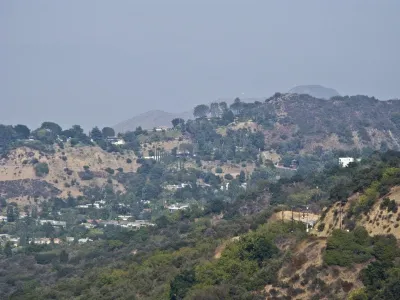A great many factors converged to create the culture and music of the 1960s. A powerful, but often overlooked, factor was the Los Angeles neighborhood of Laurel Canyon. A new documentary provides a case study in urban creativity.

"Multiple interviews over Laurel Canyon’s four-hour span refer to parties, jam sessions, and spontaneous dropping in. Many of the musicians of Laurel Canyon did not seek stardom. They sought to collaborate, to hang out. Music was their medium for doing both. Friends and strangers alike knocked on doors, guitar in one hand and a bag of grass in the other, and invited themselves in to jam, co-write, and collaborate. This was, of course, before cellphones made distance OK and Spotify made albums irrelevant. The artists of Laurel Canyon lived in splendid proximity."
"Here’s why this matters: designers and planners could never create Laurel Canyon, either in form or spirit. They could never envision ramshackle cabins, the Oedipal fury of Morrison, the extraterrestrial weirdness of Zappa, the thoughtfulness of Browne, or the bemusement of Crosby. They just cannot. But as they go about their important work, be it bureaucratic minutiae or large-scale envisioning, they should remember that places can be special—sometimes, very special."
FULL STORY: Laurel Canyon: The Classic California Urban Ecosystem

National Parks Layoffs Will Cause Communities to Lose Billions
Thousands of essential park workers were laid off this week, just before the busy spring break season.

Retro-silient?: America’s First “Eco-burb,” The Woodlands Turns 50
A master-planned community north of Houston offers lessons on green infrastructure and resilient design, but falls short of its founder’s lofty affordability and walkability goals.

Delivering for America Plan Will Downgrade Mail Service in at Least 49.5 Percent of Zip Codes
Republican and Democrat lawmakers criticize the plan for its disproportionate negative impact on rural communities.

Test News Post 1
This is a summary

Test News Headline 46
Test for the image on the front page.

Balancing Bombs and Butterflies: How the National Guard Protects a Rare Species
The National Guard at Fort Indiantown Gap uses GIS technology and land management strategies to balance military training with conservation efforts, ensuring the survival of the rare eastern regal fritillary butterfly.
Urban Design for Planners 1: Software Tools
This six-course series explores essential urban design concepts using open source software and equips planners with the tools they need to participate fully in the urban design process.
Planning for Universal Design
Learn the tools for implementing Universal Design in planning regulations.
EMC Planning Group, Inc.
Planetizen
Planetizen
Mpact (formerly Rail~Volution)
Great Falls Development Authority, Inc.
HUDs Office of Policy Development and Research
NYU Wagner Graduate School of Public Service




























